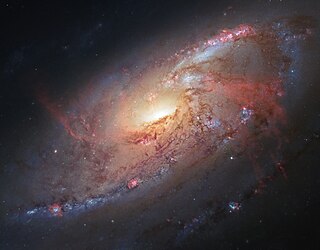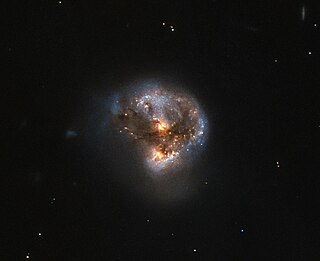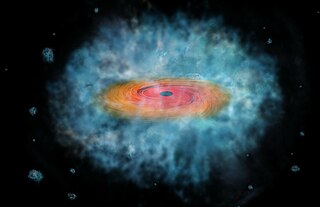Research
Diamond's research focuses on astrophysical masers. [7] [8] [9] [10]
Phil Diamond | |
|---|---|
| Born | Philip John Diamond February 18, 1958 [1] |
| Nationality | British |
| Citizenship | UK |
| Alma mater |
|
| Known for | |
| Scientific career | |
| Fields | Radio astronomy |
| Institutions | |
| Thesis | MERLIN observations of the circumstellar envelopes around OH/IR stars (1982) |
Philip John Diamond CBE HonFInstP is the Director General of the Square Kilometre Array (SKA) Organisation. [2] [3] He was the director of the Jodrell Bank Centre for Astrophysics from 1 October 2006 until 2010. He was the Chief of CSIRO's Astronomy and Space Sciences Division from 1 June 2010 [4] to October 2012.
Diamond was educated at the University of Leeds ( Bachelor of Science 1979) and the University of Manchester where he was awarded a PhD in Radio astronomy in 1982 for work on MERLIN and OH/IR stars. [1] [5] [6]
Diamond's research focuses on astrophysical masers. [7] [8] [9] [10]
Diamond was appointed Commander of the Order of the British Empire (CBE) in the 2024 New Year Honours for services to global radio astronomy. [11] [12]

A supernova is a powerful and luminous explosion of a star. A supernova occurs during the last evolutionary stages of a massive star, or when a white dwarf is triggered into runaway nuclear fusion. The original object, called the progenitor, either collapses to a neutron star or black hole, or is completely destroyed to form a diffuse nebula. The peak optical luminosity of a supernova can be comparable to that of an entire galaxy before fading over several weeks or months.

Proper motion is the astrometric measure of the observed changes in the apparent places of stars or other celestial objects in the sky, as seen from the center of mass of the Solar System, compared to the abstract background of the more distant stars.

A supermassive black hole is the largest type of black hole, with its mass being on the order of hundreds of thousands, or millions to billions, of times the mass of the Sun (M☉). Black holes are a class of astronomical objects that have undergone gravitational collapse, leaving behind spheroidal regions of space from which nothing can escape, including light. Observational evidence indicates that almost every large galaxy has a supermassive black hole at its center. For example, the Milky Way galaxy has a supermassive black hole at its center, corresponding to the radio source Sagittarius A*. Accretion of interstellar gas onto supermassive black holes is the process responsible for powering active galactic nuclei (AGNs) and quasars.

Messier 106 is an intermediate spiral galaxy in the constellation Canes Venatici. It was discovered by Pierre Méchain in 1781. M106 is at a distance of about 22 to 25 million light-years away from Earth. M106 contains an active nucleus classified as a Type 2 Seyfert, and the presence of a central supermassive black hole has been demonstrated from radio-wavelength observations of the rotation of a disk of molecular gas orbiting within the inner light-year around the black hole. NGC 4217 is a possible companion galaxy of Messier 106. Besides the two visible arms, it has two "anomalous arms" detectable using an X-ray telescope.
HD 114729 is a Sun-like star with an orbiting exoplanet in the southern constellation of Centaurus. Based on parallax measurements, it is located at a distance of 124 light years from the Sun. It is near the lower limit of visibility to the naked eye, having an apparent visual magnitude of 6.68 The system is drifting further away with a heliocentric radial velocity of 26.3 km/s. The system has a relatively high proper motion, traversing the celestial sphere at an angular rate of 0.373″·yr−1.

GRB 970228 was the first gamma-ray burst (GRB) for which an afterglow was observed. It was detected on 28 February 1997 at 02:58 UTC. Since 1993, physicists had predicted GRBs to be followed by a lower-energy afterglow, but until this event, GRBs had only been observed in highly luminous bursts of high-energy gamma rays ; this resulted in large positional uncertainties which left their nature very unclear.

An astrophysical maser is a naturally occurring source of stimulated spectral line emission, typically in the microwave portion of the electromagnetic spectrum. This emission may arise in molecular clouds, comets, planetary atmospheres, stellar atmospheres, or various other conditions in interstellar space.

A megamaser is a type of astrophysical maser, which is a naturally occurring source of stimulated spectral line emission. Megamasers are distinguished from other astrophysical masers by their large isotropic luminosity. Megamasers have typical luminosities of 103 solar luminosities (L☉), which is 100 million times brighter than masers in the Milky Way, hence the prefix mega. Likewise, the term kilomaser is used to describe masers outside the Milky Way that have luminosities of order L☉, or thousands of times stronger than the average maser in the Milky Way, gigamaser is used to describe masers billions of times stronger than the average maser in the Milky Way, and extragalactic maser encompasses all masers found outside the Milky Way. Most known extragalactic masers are megamasers, and the majority of megamasers are hydroxyl (OH) megamasers, meaning the spectral line being amplified is one due to a transition in the hydroxyl molecule. There are known megamasers for three other molecules: water (H2O), formaldehyde (H2CO), and methine (CH).

The Department of Physics and Astronomy at the University of Manchester is one of the largest and most active physics departments in the UK, taking around 330 new undergraduates and 50 postgraduates each year, and employing more than 80 members of academic staff and over 100 research fellows and associates. The department is based on two sites: the Schuster Laboratory on Brunswick Street and the Jodrell Bank Centre for Astrophysics in Cheshire, international headquarters of the Square Kilometre Array (SKA).

GRS 1915+105 or V1487 Aquilae is an X-ray binary star system containing a main sequence star and a black hole. Transfer of material from the star to the black hole generates a relativistic jet, making this a microquasar system. The jet exhibits apparent superluminal motion.
HD 196050 is a triple star system located in the southern constellation of Pavo. This system has an apparent magnitude of 7.50 and the absolute magnitude is 4.01. It is located at a distance of 165 light-years from the Sun based on parallax, and is drifting further away with a radial velocity of +61 km/s. It is also called by the Hipparcos designation HIP 101806.
W43A or IRAS 18450-0148 is a late-type star with an envelope of OH/IR type with a magnetically collimated jet. The star is in the early stages of becoming a planetary nebula, a process that will take several thousand years.
HD 196050 b is an exoplanet with a 1378-day period and a minimum mass of 2.90 Jupiter masses. The average orbital distance is 2.54 astronomical units and the orbital eccentricity is 22.8%. The periastron (closest) distance is 1.96 AU and the apastron (farthest) distance is 3.12 AU. The average orbital velocity is 20.1 km/s and the semi-amplitude is 49.7 m/s. The longitude of periastron is 187° and the time of periastron is 2,450,843 JD.

S Persei is a red supergiant or hypergiant located near the Double Cluster in Perseus, north of the cluster NGC 869. It is a member of the Perseus OB1 association and one of the largest known stars. If placed in the Solar System, its photosphere would engulf the orbit of Jupiter. It is also a semiregular variable, a star whose variations are less regular than those of Mira variables.

VX Sagittarii is an asymptotic giant branch star located more than 1.5 kiloparsec away from the Sun in the constellation of Sagittarius. It is a pulsating variable star with an unusually large magnitude range. It is one of the largest stars discovered, with a radius varying between 1,350 and 1,940 solar radii (940,000,000 and 1.35×109 km; 6.3 and 9.0 au). It is the most luminous known AGB star, at bolometric magnitude –8.6, which is brighter than the theoretical limit at –8.0.
Lambda Cygni is a class B5V star in the constellation Cygnus. Its apparent magnitude is 4.54 and it is approximately 770 light years away based on parallax.

NGC 1386 is a spiral galaxy located in the constellation Eridanus. It is located at a distance of circa 53 million light years from Earth, which, given its apparent dimensions, means that NGC 1386 is about 50,000 light years across. It is a Seyfert galaxy, the only one in Fornax Cluster.

Direct collapse black holes (DCBHs) are high-mass black hole seeds that form from the direct collapse of a large amount of material. They putatively formed within the redshift range z=15–30, when the Universe was about 100–250 million years old. Unlike seeds formed from the first population of stars (also known as Population III stars), direct collapse black hole seeds are formed by a direct, general relativistic instability. They are very massive, with a typical mass at formation of ~105 M☉. This category of black hole seeds was originally proposed theoretically to alleviate the challenge in building supermassive black holes already at redshift z~7, as numerous observations to date have confirmed.